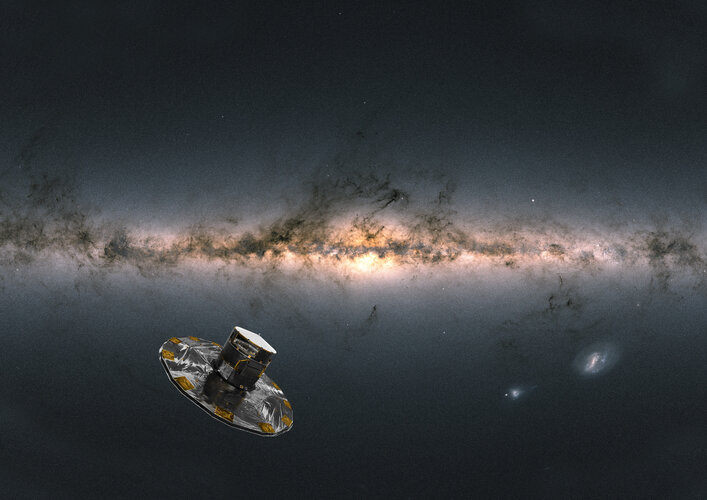
Copernical Team
ESA’s Gaia spacecraft leaves for retirement orbit
 Video:
00:02:00
Video:
00:02:00
From 25 July 2014 to 15 January 2025, the Gaia space observatory performed high-precision measurements of nearly two billion stars from its Lissajous orbit around the L2 Lagrange point, 1.5 million km from Earth.
After 10.5 years of groundbreaking observations, Gaia’s cold gas supply for attitude control has been depleted. On 27 March 2025, Gaia will leave its Lissajous orbit and transition into a stable heliocentric orbit. Soon after, the spacecraft will be passivated, with its instruments and transmitters switched off.
While Gaia will no longer collect new data, its scientific mission is far from over! The team continues
Webb spies a spiral through a cosmic lens
 Image:
Spying a spiral through a cosmic lens (Webb telescope image)
Image:
Spying a spiral through a cosmic lens (Webb telescope image) Farewell, Gaia! Spacecraft operations come to an end

The European Space Agency (ESA) has powered down its Gaia spacecraft after more than a decade spent gathering data that are now being used to unravel the secrets of our home galaxy.
On 27 March 2025, Gaia’s control team at ESA’s European Space Operations Centre carefully switched off the spacecraft’s subsystems and sent it into a ‘retirement orbit’ around the Sun.
Though the spacecraft’s operations are now over, the scientific exploitation of Gaia’s data has just begun.
Partial solar eclipse in northern areas on Saturday
This request seems a bit unusual, so we need to confirm that you're human. Please press and hold the button until it turns completely green. Thank you for your cooperation!
Press and hold the button
If you believe this is an error, please contact our support team.
185.132.36.159 : deaad8e9-2066-4db6-a92f-07ad9e76
Introducing ESA's new hyper performance computing
 Video:
00:02:46
Video:
00:02:46
The high-performance computing (HPC) environment will be available for scientific research and technological development activities, supporting all ESA programmes as well as the researchers and small- and medium-enterprises from Member States.
NASA puts biggest rocket pieces together for Artemis II moon mission
This request seems a bit unusual, so we need to confirm that you're human. Please press and hold the button until it turns completely green. Thank you for your cooperation!
Press and hold the button
If you believe this is an error, please contact our support team.
185.132.36.159 : d9e8734d-0708-425e-b8f3-2474876d
Watch wind whirl from the Sun
 Video:
00:00:43
Video:
00:00:43
Aside from sunlight, the Sun sends out a gusty stream of particles called the solar wind. The ESA-led Solar Orbiter mission is the first to capture on camera this wind flying out from the Sun in a twisting, whirling motion. The solar wind particles spiral outwards as if caught in a cyclone that extends millions of kilometres from the Sun.
Solar wind rains down on Earth's atmosphere constantly, but the intensity of this rain depends on solar activity. More than just a space phenomenon, solar wind can disrupt our telecommunication and navigation systems.
Solar Orbiter is on a mission to
Webb sees galaxy mysteriously clearing fog of early Universe

Using the unique infrared sensitivity of the NASA/ESA/CSA James Webb Space Telescope, researchers can examine ancient galaxies to probe secrets of the early Universe. Now, an international team of astronomers has identified bright hydrogen emission from a galaxy in an unexpectedly early time in the Universe’s history. The surprise finding is challenging researchers to explain how this light could have pierced the thick fog of neutral hydrogen that filled space at that time.
Planet selected to support California emissions tracking program with satellite data
 Planet Labs PBC (NYSE: PL), a prominent supplier of Earth observation data, has been named the lead subcontractor under California Air Resources Board's (CARB) Satellite Data Purchase Program (SDPP). The multi-year program, valued at $95 million, was awarded to Carbon Mapper, with Planet contributing methane monitoring data derived from its Tanager hyperspectral satellite series, alongside addit
Planet Labs PBC (NYSE: PL), a prominent supplier of Earth observation data, has been named the lead subcontractor under California Air Resources Board's (CARB) Satellite Data Purchase Program (SDPP). The multi-year program, valued at $95 million, was awarded to Carbon Mapper, with Planet contributing methane monitoring data derived from its Tanager hyperspectral satellite series, alongside addit Sidus Space Expands Presence in Asia With Orlaith AI and FeatherEdge Technology
 Sidus Space (NASDAQ: SIDU), a dynamic and forward-looking provider of space mission solutions, has secured a new purchase order from a prominent research and development institution in Asia. This agreement marks Sidus Space's inaugural collaboration in the region and demonstrates the capabilities of its proprietary space-based artificial intelligence and edge computing ecosystem, Orlaith, which
Sidus Space (NASDAQ: SIDU), a dynamic and forward-looking provider of space mission solutions, has secured a new purchase order from a prominent research and development institution in Asia. This agreement marks Sidus Space's inaugural collaboration in the region and demonstrates the capabilities of its proprietary space-based artificial intelligence and edge computing ecosystem, Orlaith, which 
